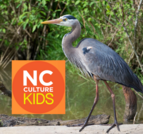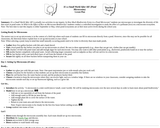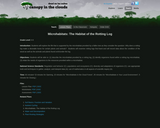
In this lesson, students go on a scavenger hunt and play a game to learn about the flow of energy through a forest ecosystem.
- Subject:
- Science
- Material Type:
- Lesson Plan
- Provider:
- University of Wisconsin-Stevens Point
- Date Added:
- 02/14/2017

In this lesson, students go on a scavenger hunt and play a game to learn about the flow of energy through a forest ecosystem.

In this short video, join Brandon and Emily on a nature hike with Falyn from the NC Wildlife Resources Commission as they discover all kinds of plants and animals and learn a thing or two about the amazing nature of North Carolina!

In this lesson, students will design and use a simple model to test cause and effect relationships or interactions concerning the functioning of a marine food web, ranking their hypothetical ecosystems according to their stability when faced with a natural or man-made disturbance.

Attached is a 5 E lesson plan to use over 8-10 class periods. Students will research the interactions of plants and animals in different ecosystems.
Graphic organizer to guide students research is also attached.
After students complete research they will form ecosystem based groups to learn more about current threats and conservation efforts needed to preserve the ecosystem. They will create a "Spread the Word" media project to share publicly school wide.
You can also do some sort of conservation service learning activity to help students take their knowledge into the community. For instance, we do Adopt-a-Stream through our city. We clean and test the water in the stream across form our school twice a year.

Students are introduced to ecosystems, food webs, and keystone species. They draw a simple food web and predict the impact keystone species have on an ecosystem.

Students will observe living things in a wooded area near the school. They will list all living things they observe in a journal along with a question about each observation. After returning to the school, students will be introduced to the vocabulary: producers, consumers, decomposers, and food web. Students will select a question that can be investigated and share with the class. The teacher will guide the class to use the same question to investigate. How do these living things affect each other? Each student will organize their data into the three categories of producers, consumers, and decomposers. Using one of their living things, they will create a food web with at least one living thing from each of the three categories. Students will predict what would happen if one of the living things in the food web became extinct or over productive. An extension will be to investigate living things at a wetlands area.

It's a Small World After All! is actually two activities in one inquiry. In "How Much Biodiversity Exists in a Pond Microcosm?" students use microscopes to investigate the diversity of life that exists in pond water. In "What Is the Effect of Rice on Microcosm Biodiversity?" students conduct a controlled investigation to study the effect of a pollutant (rice) on a microcosm ecosystem. Note: The best time to start this inquiry is either September or May, when pond ecosystems are at their most active levels during the school year.

In this lesson, students learn about kelp forest ecosystems and how organisms interact with each other in a kelp forest ecosystem. They will also learn about potential threats to these ecosystems and determine how humans can impact the kelp forests, both negatively and positively.

Students use photos and information about Australia's Shark Bay to draw and label a simple food web. Then they identify which animal in the ecosystem is a keystone species.

Students will learn about brown bears and their feeding habits. They will then create a food web with the Alaskan brown bear at the top.

This resource supports English language development for English language learners. The Nature's Recyclers Coloring Book teaches children about decomposers and recycling. Downloadable PDF.

Looking for lichens is an activity that can be done almost anywhere. Students get to search for them in the playgrounds and schoolyards, and they can be used as an indicator of air quality.

In this lesson, students will learn about the complexity of ecosystems, including the classification of different ecosystems, the elements that compose them, and the food webs that form in an ecosystem. They will also learn the basics of photosynthesis and its importance for life on our planet. On this basis, they will reflect on the importance of protecting ecosystems and conduct research to provide solutions to environmental problems in their community. Students will have many opportunities to practice formal and informal writing, to compare and contrast the elements of different types of texts, and to strengthen their writing skills by writing a variety of texts according to the needs of the lesson. The students, moreover, will integrate the use of technology as part of their learning and communication process. Finally, the content and activities of the lesson will provide the appropriate context for students to practice a variety of skills and strategies that will support their capacity for critical thinking, analysis, organizing ideas and information, self-correcting and monitoring their learning.

In this lesson, students construct a habitat for macroinvertebrates. Then they will develop a model to describe the manor and the movement of matter among the plants, animals, decomposers and the environment. This project is designed to span a month or longer.

Students review the concept that matter cycles in a food chain. They will participate in a reader's theater skit presentation that describes the roles that producers, consumers, and decomposers play in an ecosystem.

Students will explore the life that is supported by the microhabitat provided by a fallen tree as they consider the question: Why does a rotting log make a desirable home for certain plants and animals? Students will examine rotting logs first-hand and will record data about the condition of the wood as well as the animals and plants found on/in/under the log.

In this lesson, students learn that microorganisms can be both beneficial and harmful; one benefit is their decomposer role in the cycling of matter.

In this short video and accompanying activity and readings, students learn about Longleaf Pine Ecosystems by exploring Weymouth Woods Sandhills Nature Preserve in North Carolina.

In this lesson, students will identify biotic and abiotic factors in the biosphere. They will describe the characteristics of populations and compare a species' habitat and its niche within a community.

This online game allows students to identify producers, consumers, and decomposers.